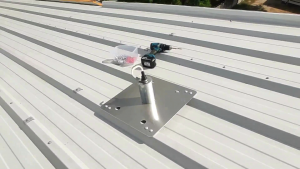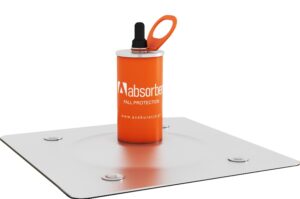Anchorage point
The importance of a proper anchoring point for personal protection equipment against falls from a height is undeniable. Before using said point, the user should determine whether the point has the appropriate location, stability and durability.
Anchorage point durability
An appropriate anchorage point should withstand the maximum braking force including a safety margin. Relevant standards and regulations define the minimum load that an anchor point should have.
Single anchor points
The static durability of an anchor point which is not part of a larger horizontal fall protection system should be 12 kN when securing one worker. In accordance with European and Polish standards, the maximum braking force (Fmax) is 6 kN, we use the 2 x Fmax method when designing fall protection systems. Using a certified shock absorber, the maximum braking force should not exceed 6 kN when a person weighing 100 kg falls with a free fall distance not exceeding 4 m.
Anchor points in horizontal fall protection systems
Horizontal fall protection systems are a very popular solution. It should be remembered that the anchor points, which are part of such a system, must have adequate strength – 12 kN in the case of systems with rigid guideways, e.g. in the form of a horizontal rail, and 1.5 times greater than the individual components for systems using a flexible guidway in the form of a rope.
When using horizontal rope fall protection systems, we must remember that the maximum braking force acting on the safety rope generates dynamic forces acting on its ends, in this case our anchor points. We call these forces the maximum braking load. It is usually much larger, and without the use of an appropriate shock absorber, it can reach even 15 times the maximum braking force.
Changing the vertical direction of the maximum braking force to the horizontal of the maximum braking load causes that all calculations must take into account a number of parameters such as the initial tension or deflection of the rope, its stiffness, etc. Therefore, such calculations are so complicated that appropriate software is needed for this. These issues are so complex that it is necessary to use the services of professionals who design and install horizontal fall protection systems.
Anchorage point stability
The structure on which our anchor point is located should be stable enough not to overturn during a fall. Of course, the anchor points that are part of fixed structures such as a columns, walls or beams are not subject to a lack of adequate stability. This issue is extremely important in the case of points on mobile platforms or scaffolding. Fall protection systems should not be installed on this type of mobile structure without stabilizing it first. Before using this type of anchor points, we should check the appropriate tensions and counterweights, they may require adjustment.
Anchoring point location
In order to reduce the free fall path and to prevent the occurrence of the pendulum phenomenon during a fall, personal protection equipment should be strapped to a point located directly above the user. If the user has the option to select the point to which to connect, use a point as high as possible, this will reduce the looseness of the safety rope and shorten the free fall path. Space under the workplace should assume the total fall distance plus at least one meter of clearance for safety.
Free fall path reduction
Using the anchor points at our feet can be extremely dangerous. Such a low position causes the total free fall path to be drastically longer. Therefore, it is recommended to use horizontal rope or rail fall protection systems. If this is not possible, safety poles are a good alternative. The use of self-locking devices also reduces free fall. In order to choose the right solution, you should consult experts in the field of protection against falls from a height.
Pendulum phenomenon reduction
It can be difficult, sometimes even impossible, to completely eliminate the pendulum effect. Pay attention to the objects in the path of a possible swinging fall and choose the appropriate anchor points, the location of which will not expose the user to a collision with them. As long as work is carried out on a vertical line from the anchor point, the risk of a swinging fall will be reduced.
Summary
The decisive factor for not-traumatic fall is the appropriate location of the anchor point. In many situations, the user has a choice. That is why it is so important to properly train employees so that they can choose the right point for any given situation. On the roofs of buildings, we often deal with fixed points, therefore in such situations it is the specialist dealing with work safety at height who should select the type of points used and their location.



